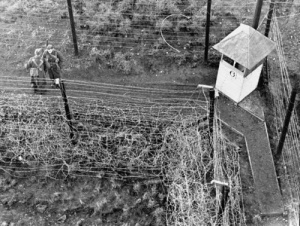I was watching David Birch talk about The Internet of everyone elses things, truth be told, someone was watching the new Irish budget on TV, i had to find something else to occupy myself, and this was it.
Now, it would appear there is an issue with forgeries in all sorts of products all over the world. In architecture its called duplitecture, but if you are selling to consumers in department stores, it can be tricky
The problem facing consumers in stores is…
How do i know this product is real?
One of problem facing manufacturers is…
How do we keep our reputation and ensure the customer can know its our product?
Is Del boy selling whiskey in Korea?
It would appear in Korea there is a problem with knock off scotch whiskey, the solution they came up with was to put RFIDs in the bottle cap.
RFIDs
As a customer, you can scan the RFID with your phone in the store, you can verify the bottle with the manufacturer, the manufacturer can confirm that the bottle you are holding is from them, then PARTY TIME!
PLUS, when you open the bottle, the RFID is broken, so it cannot be copied.
Good no?
Well connecting things is easy, just ask people at Nokia, no better ask people who love connecting stuff in IKEA.
IKEA sold a chair, it was hacked into a kids bike
Making doors is easy, making the locks? Not quite.
IKEA hacking has a big hacker following, get the app
Back to the story, David pointed out, walls have ears and so does everything else.
To ensure security against hackers, you must have a:
- Product
- Properties
- Provenance, it has a history, it didnt just pop into the world
Some other useful ideas for RFIDs, (besides your cat) are to stop illegal logging, you can hammer a RFID nail into a tree and track every log out of a forest to the Mill, stopping illegal overnight, sounds good to me?
If you can verify the entire history of a bottle of whiskey to a log of wood, you can be sure of what you are getting is the real thing, good for whiskey drinkers and good for the Amazon.
A few weeks ago, i listened to a podcast about Devils rope
Many types of Devils ropes, but which one?
Back in the 1800s, the U.S. government wanted farmers to move west, because farmers, unlike cattlemen, would establish communities and build permanent settlements. In 1862, President Lincoln signed the Homestead Act, offering 160 acres of free land to anyone who settled and farmed it for five years.
The land in the middle of America was useless for farming, as there was buffalo and cows that would come and eat all your crops, it was impossible to farm this land, only by securing the land would the land prove useful.
The thorny Osage orange was good, but it took five years to grow
Along came a farmer from Hampshire called Joseph Giddon with the solution. Glidden’s design took off, and by 1876, his company was producing nearly three million pounds of barbed wire annually.
Cattle men weren’t happy, this wire stopped them crossing vast areas of land, barbed wire fences were in direct contradiction to “the law of the open range” and also could injure or maim cattle.
The cattlemen ended up resenting the farmers as they put up more and more fences. And that’s what lead to the fence-cutting wars.
Everyone knows its hard to be angry when your singing a song…
The farmer and the cattle man should be…?
Now the bad news, before white people lived in the west, there were an estimated 65 million buffalo roaming the plains. By the end of the century, there were fewer than a thousand.
This had a huge knock on effect for native Americans, who ended up calling Barbed wire “Devils rope”
Devils rope had other uses too
Barbed wire’s history has mostly been about control, possession and separation but there is one instance where barbed wire was used not to separate us, but to connect us, longhorn out, Bell in.
With the invention of the telephone, some of the earliest adopters of the technology were farmers, they already had fences, the network, they lived remote, they needed to talk to one another
For about 25 dollars, farmers could buy a kit to rig themselves into their network. In 1907 there were 18,000 independent telephone cooperative serving nearly a million and half people
First there was the thing, and one thing led to another…
Introducing the Internet of everyone elses things











